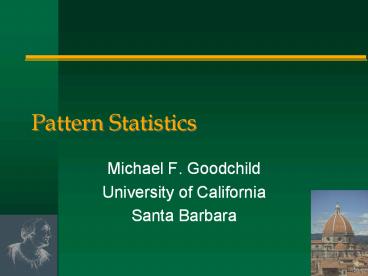Pattern Statistics - PowerPoint PPT Presentation
Title:
Pattern Statistics
Description:
Point patterns. What are we trying to do? Infer process ... A pattern can be clustered at one scale and random or dispersed at another. Poisson test ... – PowerPoint PPT presentation
Number of Views:55
Avg rating:3.0/5.0
Title: Pattern Statistics
1
Pattern Statistics
- Michael F. Goodchild
- University of California
- Santa Barbara
2
Outline
- Some examples of analysis
- Objectives of analysis
- Cross-sectional analysis
- Point patterns
3
(No Transcript)
4
(No Transcript)
5
(No Transcript)
6
(No Transcript)
7
(No Transcript)
8
(No Transcript)
9
(No Transcript)
10
What are we trying to do?
- Infer process
- processes leave distinct fingerprints on the
landscape - several processes can leave the same fingerprints
- enlist time to resolve ambiguity
- invoke Occam's Razor
- confirm a previously identified hypothesis
11
Alternatives
- Expose aspects of pattern that are otherwise
invisible - Openshaw
- Cova
- Expose anomalies, patterns
- Convince others of the existence of patterns,
problems, anomalies
12
Cross-sectional analysis
- Social data collected in cross-section
- longitudinal data are difficult to construct
- difficult for bureaucracies to sustain
- compare temporal resolution of process to
temporal resolution of bureaucracy - Cross-sectional perspectives are rich in context
- can never confirm process
- though they can perhaps falsify
- useful source of hypotheses, insights
13
What kinds of patterns are of interest?
- Unlabeled objects
- how does density vary?
- do locations influence each other?
- are there clusters?
- Labeled objects
- is the arrangement of labels random?
- or do similar labels cluster?
- or do dissimilar labels cluster?
14
First-order effects
- Random process (CSR)
- all locations are equally likely
- an event does not make other events more likely
in the immediate vicinity - First-order effect
- events are more likely in some locations than
others - events may still be independent
- varying density
15
(No Transcript)
16
(No Transcript)
17
Second-order effects
- Event makes others more or less likely in the
immediate vicinity - clustering
- but is a cluster the result of first- or
second-order effects? - is there a prior reason to expect variation in
density?
18
Testing methods
- Counts by quadrat
- Poisson distribution
19
Deaths by horse-kick in the Prussian army
- Mean m 0.61, n 200
20
Towns in Iowa
- 1173 towns, 154 quadrats 20mi by 10mi
Chisquare with 8 df 12.7 Accept H0
21
Distance to nearest neighbor
- Observed mean distance ro
- Expected mean distance re 1/2?d
- where d is density per unit area
- Test statistic
22
Towns in Iowa
- 622 points tested
- 643 per unit area
- Observed mean distance 3.52
- Expected mean distance 3.46
- Test statistic 0.82
- Accept H0
23
But what about scale?
- A pattern can be clustered at one scale and
random or dispersed at another - Poisson test
- scale reflected in quadrat size
- Nearest-neighbor test
- scale reflected in choosing nearest neighbor
- higher-order neighbors could be analyzed
24
Weaknesses of these simple methods
- Difficulty of dealing with scale
- Second-order effects only
- density assumed uniform
- Better methods are needed
25
K-function analysis
- K(h) expected number of events within h of an
arbitrarily chosen event, divided by d - How to estimate K?
- take an event i
- for every event j lying within h of i
- score 1
26
Allowing for edge effects
score lt 1
27
The K function
- In CSR K(h) ?h2
- So instead plot
28
What about labeled points?
- How are the points located?
- random, clustered, dispersed
- How are the values assigned among the points?
- among possible arrangments
- random
- clustered
- dispersed
29
(No Transcript)
30
Moran and Geary indices
31
(No Transcript)































